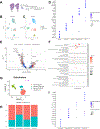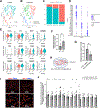Osteopontin drives neuroinflammation and cell loss in MAPT-N279K frontotemporal dementia patient neurons
- PMID: 38626772
- PMCID: PMC11373574
- DOI: 10.1016/j.stem.2024.03.013
Osteopontin drives neuroinflammation and cell loss in MAPT-N279K frontotemporal dementia patient neurons
Abstract
Frontotemporal dementia (FTD) is an incurable group of early-onset dementias that can be caused by the deposition of hyperphosphorylated tau in patient brains. However, the mechanisms leading to neurodegeneration remain largely unknown. Here, we combined single-cell analyses of FTD patient brains with a stem cell culture and transplantation model of FTD. We identified disease phenotypes in FTD neurons carrying the MAPT-N279K mutation, which were related to oxidative stress, oxidative phosphorylation, and neuroinflammation with an upregulation of the inflammation-associated protein osteopontin (OPN). Human FTD neurons survived less and elicited an increased microglial response after transplantation into the mouse forebrain, which we further characterized by single nucleus RNA sequencing of microdissected grafts. Notably, downregulation of OPN in engrafted FTD neurons resulted in improved engraftment and reduced microglial infiltration, indicating an immune-modulatory role of OPN in patient neurons, which may represent a potential therapeutic target in FTD.
Keywords: FTD; MAPT N279K; OPN; Spp1; Tau; disease modeling; frontotemporal dementia; induced pluripotent stem cells; microglia; neuroinflammation; osteopontin; single nucleus RNA sequencing; snRNA-seq; transplantation.
Copyright © 2024 The Authors. Published by Elsevier Inc. All rights reserved.
Conflict of interest statement
Declaration of interests Z.K.W. serves as PI or co-PI on Biohaven Pharmaceuticals, Inc. (BHV4157-206), Vigil Neuroscience, Inc. (VGL101-01.002, VGL101-01.201), and ONO-2808-03 projects/grants. He serves as co-PI of the Mayo Clinic APDA Center for Advanced Research and as an external advisory board member for Vigil Neuroscience, Inc. and as a consultant for Eli Lilly & Company and for NovoGlia, Inc.
Figures







References
-
- Goedert M, Spillantini MG, Jakes R, Rutherford D, and Crowther RA (1989). Multiple isoforms of human microtubule-associated protein tau: sequences and localization in neurofibrillary tangles of Alzheimer’s disease. Neuron 3, 519–526. 0896–6273(89)90210–9 [pii]. - PubMed
-
- Ghetti B, Oblak AL, Boeve BF, Johnson KA, Dickerson BC, and Goedert M. (2015). Invited review: Frontotemporal dementia caused by microtubule-associated protein tau gene (MAPT) mutations: a chameleon for neuropathology and neuroimaging. Neuropathol Appl Neurobiol 41, 24–46. 10.1111/nan.12213. - DOI - PMC - PubMed
Publication types
MeSH terms
Substances
Grants and funding
LinkOut - more resources
Full Text Sources
Molecular Biology Databases
Research Materials
Miscellaneous

